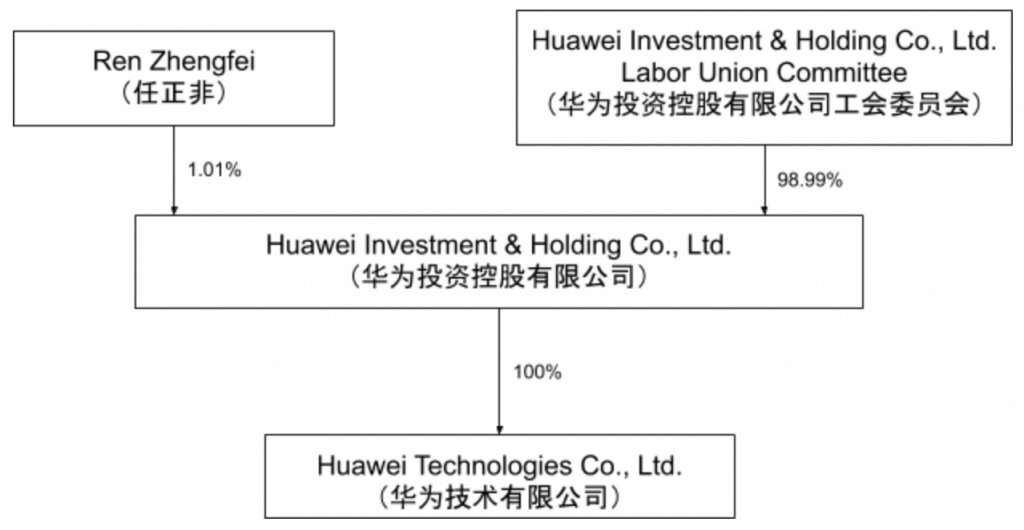The Mystery of Huawei’s Ownership
Yesterday, the White House banned the use of foreign telecommunications equipment in the United States, and the U.S. Department of Commerce placed restrictions on the sale of U.S. technology to Huawei Technologies Co., Ltd.
These actions come amidst a surging debate in Washington about the influence of Chinese technology companies within the United States, which has seen many U.S. academics, journalists, and lawmakers raising questions about the control and ownership of Huawei, the world’s largest manufacturer of telecommunications equipment.
Huawei claims to be owned entirely by its employees, but verifying this claim is a tricky proposition. We don’t have visibility into the internal governance of Huawei’s trade union committee. However, comparing Huawei to other Chinese corporations reveals that Huawei’s ownership is highly unusual.
Using Chinese corporate data, we determined that Huawei’s ownership structure is very uncommon, particularly for a company of its size. Fewer than three hundredths of one percent (0.0249%) of active Chinese corporations in our dataset are owned by trade union committees, like Huawei.
Who Owns Huawei?
Huawei is the world’s largest telecommunications equipment manufacturer and second-largest smartphone manufacturer. Understanding who owns Huawei—and their motivations and vulnerabilities—is crucial to assessing the reliability of networks built on Huawei technology.
Huawei’s technologies are central components of telecommunications infrastructure around the world. The company is investing heavily to develop 5G, the next generation of telecommunications technology. As former FBI general counsel Jim Baker recently argued, the security and reliability of these technologies is a critical national security question. Many outside China have long questioned whether the Chinese Communist Party (CCP) would refrain from exerting influence or control over Huawei, given its size and strategic importance.
Ownership by Labor Union Committee
The debate about who exactly owns Huawei is not new. As early as 2013, Chinese journalists were questioning “the foggy ownership of Huawei-system companies.”
Recently, two experts on Chinese business and law, Christopher Balding and Donald Clarke, reignited this debate in a paper asking simply, “Who Owns Huawei?” Using Chinese corporate records, they determined that Huawei is 98.99% owned by Huawei Investment & Holding Co., Ltd. Labor Union Committee, the committee that oversees the labor union of Huawei’s top holding company.
According to Balding and Clarke, employees hold “virtual shares” of this holding company. These shares grant contractual rights to a portion of the company’s profits but only limited rights to control the decisions of that labor union committee or elect its officers.

Fig. 1. Huawei ownership chart, generated by author, based on Balding and Clarke article
However, Balding and Clarke conclude it is highly unlikely that Huawei’s employees actually own or control this labor union committee, as the company has claimed.
But How Unusual is Huawei’s Ownership Really?
China’s history of state ownership and unique path of gradual liberalization has led, unsurprisingly, to some unique legal and corporate forms. China legally abolished private ownership of land in 1956. The two most common forms of Chinese corporate entity—household enterprises (个体工商户) and limited liability companies (有限责任公司)—don’t map perfectly to their analogs in other countries. Even privately owned corporate entities can be subject to party-state control through CCP branches within the company.
To Americans, then, common Chinese corporate structures can seem opaque and strangely convoluted, if not downright shady. Knowing this, it is important to consider Huawei’s ownership in a Chinese context. Is there actually anything unusual—and, therefore, potentially significant—about Huawei’s ownership structure?
We set out to answer this question using Sayari’s database of 55 million Chinese corporate entities.
Yes, Huawei’s Ownership is Unusual
Of these 55 million Chinese corporate entities, approximately 38 million are active. We define this as not reporting an operating status of dissolved or under liquidation or as not having had their operating license or registration recalled, repealed, revoked, or cancelled.
Of these 38 million active entities, approximately 18 million are corporate types that could have labor union committees as shareholders. In other words, no individual/household enterprises (个体户).
Ownership by a “committee” (委员会) is rare but not unheard of in China. Nearly 45,000 active corporate entities list a shareholder with “committee” in its name. Most of these appear to be companies owned by local government offices, but there are some exceptions. For example, one Kunming-based construction company is owned by a branch of the Revolutionary Committee of the Chinese Kuomintang, one of China’s nominally independent minor political parties.
But ownership by a “labor union committee” (工会委员会), like the Huawei case, is very rare. We identified just 4,547 active Chinese corporate entities that list a labor union committee as a shareholder. This represents just 0.0249% of the active non-household enterprise companies in our dataset. Among companies operating in the technology sector, ownership by a labor union committee is even more rare. Only 794 active technology companies in our database—or 0.0201%—are owned directly by a labor union committee.
Of these 794 companies, Sayari was able to identify the registered capital in Chinese Renminbi for 526. Of these, just three had registered capital greater than 1 billion RMB (approx. USD $148 million); Huawei has registered capital of more than 16 billion RMB. Chinese companies of this size usually are major state-owned enterprises, publicly-traded, or both. In other words, it is practically unheard of in China for a labor union committee to own a company of Huawei’s size, scope, and global reach.
Why this Unusual Ownership?
Contrary to popular belief, China is remarkably transparent when it comes to corporate ownership. You can trace the shareholders of most Chinese companies back to their ultimate beneficial owners. At the top of the chain, you will find one or more individuals who make decisions for the company and reap the financial benefits of its activities.
State-owned entities are a notable exception. The State-owned Assets Supervision and Administration Commission (SASAC) or its analogs in local governments supervise and control state-owned entities. But, even in these cases, Chinese law ensures some transparency into their ultimate controlling parties. SASAC is headed by a Chairman and Party Secretary, and the Chairman is appointed by the State Council.
By comparison, the internal governance structure of the Huawei Investment & Holding Co., Ltd. Labor Union Committee is totally opaque. As if this weren’t troubling enough, our data confirms that Huawei’s ownership structure is not only opaque but also highly unusual in China.
This begs the question: why?
Policymakers concerned about the national security implications of Huawei’s global reach—whether in Washington, New Delhi, or Berlin—should continue to press for greater transparency. Who makes decisions for Huawei? Who stands to benefit from its actions? And why is its structure so unusual?
The Chinese corporate records data that powered this research is available through Sayari Graph, along with hundreds of millions of other public records from around the world! If you’re curious how this data could drive insights for your team, please reach out here.



